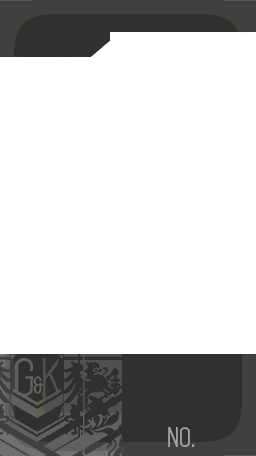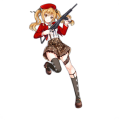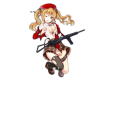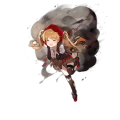Difference between revisions of "Sten MkII"
AutumnsFall (talk | contribs) |
AutumnsFall (talk | contribs) m |
||
| (3 intermediate revisions by the same user not shown) | |||
| Line 18: | Line 18: | ||
The Sten was created during a time of desperation. The British military had suffered great materiel losses during the evacuation at Dunkirk, and needed a submachine gun that could be quickly manufactured to help resupply the armed forces. At the time, the British had been purchasing large quantities of Thompson submachine guns from the United States. However, Thompsons were time-consuming and expensive to produce, being anywhere from $70-200 per unit. As a result, the guns could not be produced fast enough, and so the Royal Small Arms Factory Enfield was commissioned to design an alternative.<ref name = "sten modernfirearms">[https://modernfirearms.net/en/submachine-guns/great-britain-submachine-guns/sten-eng/ Modern Firearms entry on the STEN]</ref> | The Sten was created during a time of desperation. The British military had suffered great materiel losses during the evacuation at Dunkirk, and needed a submachine gun that could be quickly manufactured to help resupply the armed forces. At the time, the British had been purchasing large quantities of Thompson submachine guns from the United States. However, Thompsons were time-consuming and expensive to produce, being anywhere from $70-200 per unit. As a result, the guns could not be produced fast enough, and so the Royal Small Arms Factory Enfield was commissioned to design an alternative.<ref name = "sten modernfirearms">[https://modernfirearms.net/en/submachine-guns/great-britain-submachine-guns/sten-eng/ Modern Firearms entry on the STEN]</ref> | ||
| − | The design of the Sten gun is credited to Major Reginald V. Shepherd and Mr. Harold John Turpin. Major Shepherd was the inspector of Armaments in the Ministry of Supply Design Department at The Royal Arsenal in Woolwich, while Turpin was the Senior Draughtsman of the Design Department at Enfield. The design they came up with shared many design elements, such as its side-mounted magazine, with an earlier submachine gun design, the Lanchester (a British copy of the German MP28). Unlike the | + | The design of the Sten gun is credited to Major Reginald V. Shepherd and Mr. Harold John Turpin. Major Shepherd was the inspector of Armaments in the Ministry of Supply Design Department at The Royal Arsenal in Woolwich, while Turpin was the Senior Draughtsman of the Design Department at Enfield. The design they came up with shared many design elements, such as its side-mounted magazine, with an earlier submachine gun design, the Lanchester (a British copy of the German MP28). Unlike the Lanchester, however, the Sten was designed to be as cheap and easy to produce as possible. To this end, the Sten was built primarily of simple stamped metal components and required only minor welding, which meant minimal machining and manufacturing was needed to build one. In terms of mechanical operation, the Sten was also incredibly simple. The Sten was a blowback-operated submachine gun firing from an open bolt, with a fixed firing pin on the face of the bolt. This means the bolt remains to the rear when the weapon is cocked, and on pulling the trigger the bolt moves forward from spring pressure, stripping the round from the magazine, chambering it, and firing the weapon all in the same movement. There is no breech locking mechanism, so the rearward movement of the bolt caused by the recoil impulse is arrested only by the mainspring and the bolt's inertia. The German MP40, Russian PPSh-41, and US M3 submachine guns were all made with a similar design philosophy to that of the Sten: simple to make, easy to maintain, and cheap to produce.<ref name = "sten forgotten weapons">[https://www.youtube.com/watch?v=8-PmLxkOmaM Forgotten Weapons video on British submachine guns]</ref> |
| − | The Sten gun | + | The Sten gun was known to suffer from a number of design faults. Stoppages were not uncommon, and could occur for a variety of reasons, some as a result of poor maintenance while others were particular to the Sten. Carbon buildup on the face of the breech or debris in the bolt raceway could cause a failure to fire, while a dirty chamber could cause a failure to feed. Firing the Sten by grasping the magazine with the supporting hand tended to wear the magazine catch, altering the angle of feed and causing a failure to feed. Additional problems stemmed from the Sten's magazine, which was a direct copy of the one used in the German MP40. The magazine had two columns of 9mm cartridges in a staggered arrangement, merging at the top to form a single column. While other staggered magazines, such as the Thompson, fed from both the left and right side alternately, the Sten magazine required the cartridges to gradually merge at the top of the magazine to form a single column. As a consequence, any dirt or foreign matter in this taper area could cause feed malfunctions. Additionally, the walls of the magazine lip had to endure the full stresses of the rounds being pushed in by the spring. This, along with rough handling could result in deformation of the magazine lips (which required a precise 8° feed angle to operate), resulting in misfeeding and a failure to fire. The slot on the side of the body where the cocking knob ran was also a target of criticism, as the long opening could allow foreign objects to enter. The open bolt design combined with cheap manufacture and rudimentary safety devices also meant the weapon was prone to accidental discharges, which proved hazardous. A simple safety could be engaged while the bolt was in the rearwards (cocked) position. However, if a loaded Sten with the bolt in the closed position was dropped, or the butt was knocked against the ground, the bolt could move far enough rearward to pick up a round (but not far enough to be engaged by the trigger mechanism) and the spring pressure could be enough to chamber and fire the round. |
| − | The STEN would see improvements | + | The STEN would see various improvements following its adoption in 1941. The first model of Sten gun produced, the Mk.I, featured a conical flash hider, a wooden grip on the stock, and a wooden front grip that could be folded up under the barrel. Only about 100,000 of Mk.I Stens were produced before the far simpler Mk.II. The Mk.II was the most common version of the STEN at 2 million units produced. The foregrip and flash hider from the earlier Mk.I were removed from this variant, and a simplified stock design was used. The simplification of the Sten gun design would culminate in the Mk.III, which would end up being the 2nd most produced variant, as well as the version in use by the time of the Normandy landings. The Sten, especially the Mk.II, tended to attract affection and loathing in equal measure. Its peculiar appearance when compared to other firearms of the era, combined with sometimes questionable reliability, made it unpopular with some front-line troops. However, a well-maintained (and properly functioning) Sten gun was a devastating close-range weapon for sections previously armed only with bolt-action rifles. In addition to regular British and Commonwealth military service, Stens were air-dropped in large numbers to resistance fighters and partisans throughout occupied Europe. Due to their slim profile and ease of disassembly/reassembly, they were good for concealment and guerrilla warfare. |
| − | |||
| − | |||
| − | |||
| − | The | + | The Sten, even with all its faults, served through the Second World War and into the Korean War. The Sten was replaced by the Sterling submachine gun in 1953, and was gradually withdrawn from British service beginning in the 1960s. Other Commonwealth nations followed suit, either by creating their own replacements, such as the Australian F1 submachine gun, or adopting foreign designs. The Sten does continue to occasionally show up in the hands of insurgents, militias, and irregular military forces. |
| − | |||
| − | |||
| − | |||
| − | |||
| − | |||
| − | |||
| − | |||
| − | |||
| − | |||
| − | |||
| − | | design = | + | |design = |
| − | A short T-doll around 130-140cm | + | A short T-doll around 130-140cm in height (when using her weapon for scale), Sten has golden eyes and medium length blonde hair tightened in twin ponies. |
| − | As the artist revealed on his/her weibo posts, | + | As the artist revealed on his/her weibo posts, Sten's original concept design was similar to Little Red Riding Hood, as advised by {{doll name|Beretta Model 38|SMG|2}}'s artist ALLENES, who suggested that they "Give her a little red hat". By a 'red hat', ALLENES apparently meant a red beret.<ref name= "weibo1">[https://weibo.com/1936540534/D0XZdkuPS?from=page_1005051936540534_profile&wvr=6&mod=weibotime&type=comment#_rnd1524382516452 Artist Weibo Post #1]</ref> |
| − | + | Due to the weapon being meant as a cheap alternative due to lack of funding, the second draft of Sten's design was given a plain grey dress, similar to Cinderella's.<ref name= "weibo2">[https://weibo.com/1936540534/D0Y0Gk8aF?type=comment#_rnd1524382513114 Artist Weibo Post #2]</ref> | |
| − | Finally 真名 settled with a feminized version of the traditional English working class outfit of that era | + | Finally, 真名 settled with a feminized version of the traditional English working class outfit of that era: a suspension-belt skirt, red jacket, beret, and a white shirt. |
|min_dmg= 9 | |min_dmg= 9 | ||
| Line 111: | Line 98: | ||
</gallery> | </gallery> | ||
| − | | trivia = | + | | trivia = |
| − | * | + | *The Sten gun first saw action in the Dieppe raid with Canadian Forces. Weeks prior to the raid, the first issuing of the Sten gun to the Dieppe Raiders occurred, and during the weeks leading up to the raid the Canadians spent the time fixing, filing, and adjusting their weapons' to fix faults, making them somewhat decent and fully battle-worthy guns.<ref name = "sten canadian soldiers">[https://www.canadiansoldiers.com/weapons/smgs/sten.htm CanadianSoldiers.com entry on the STEN]</ref> However, when the raid was first cancelled in July, the Canadians' modified STENs were withdrawn. When the raid was later remounted, the Canadian forces received new Sten guns, crated and packed in grease, which were very much useless as they had their very common manufacturing defects which the Canadians had corrected weeks prior to their previously issued guns. This obviously disgusted many of the troops. The Dieppe raid in the end was a catastrophic failure, seeing 3.6 thousand of the 6000 predominantly Canadian soldiers being killed, wounded, or captured due to extremely poor British leadership.<ref name = "sten dieppe wiki">[https://en.wikipedia.org/wiki/Dieppe_Raid Wikipedia entry on the Dieppe Raid]</ref> |
| − | + | *As a reference to a joke told by Allied troops regarding the Sten's tendency to accidentally discharge when dropped, one of the official 4Coma comics of Girls' Frontline drawn by AC-130 depicts {{doll name|Lee-Enfield|RF|5}} throwing Sten's weapon like a grenade at a group of enemy patrols to drive them away. | |
| − | + | *The Sten Mk. II was one of the weapons used by Jozef Gabčík, the leader of the Czechoslovakian SOE team tasked with assassinating SS-Obergruppenführer Reinhard Heydrich. Unfortunately, in line with the STEN's famous unreliability issues, the firearm jammed. Seeing this, anoher member of the group, Jan Kubiš, proceeded to toss a modified Anti-Tank grenade into Heydrich's car after Heydrich ordered the driver to stop so he could shoot Gabčík. The resulting explosion severely injured Heydrich, and several months later caused him to enter a coma he never awoke from. Both Gabčík and Kubiš later died after a 6 hour long gunfight against the SS at a cathedral in Prague along with the rest of the paratrooper team that was inserted by the SOE. | |
| − | + | **Sten's in-game skill, a hand grenade, is a tribute to Jozef Gabčík and Jan Kubiš' actions during the war. | |
| − | * | + | *Captured Sten Mk. II submachine guns were redesigned by the Germans, and designated the MP 3008(or Gerät Neumünster). The MP 3008 shared the same receiver design as the Sten, but changed the location of the magazine. The MP 3008 was used by the Fallschirmjägers(German paratroopers) and the Volksturm because of its reliability and cheaper maintenance cost than its counterparts, the MP 40.<ref>[https://en.wikipedia.org/wiki/MP_3008 Wikipedia article on the MP 3008]</ref> |
| − | * The Sten Mk. II | + | *Following her neural upgrade, Sten switches to using a Mk.IIS, an integrally suppressed version of the Sten produced at the request of the Special Operations Executive (SOE) for use in clandestine operations in occupied Europe. |
| − | ** | ||
| − | * Captured Sten Mk. II | ||
| − | * | ||
| − | |||
| − | |||
| − | |||
| − | |||
}} | }} | ||
[[Category:T-Dolls with censoring]] | [[Category:T-Dolls with censoring]] | ||
Revision as of 01:20, 28 November 2020
| Sten MkII | Story | Quotes |
Sten MkII29
    | |
| Gun Information | |
|---|---|
| Full name | STEN |
| Country of origin | United Kingdom |
| Manufacturer | Royal Small Arms Factory Enfield, Birmingham Small Arms Company, ROF Fazakerley, ROF Maltby, ROF Theale, Berkshire, Lines Brothers Ltd, Long Branch Canada (plus numerous sub-contractors making individual parts), Various Underground Resistance Group Factories. |
| Game Information | |
| Faction | Griffin & Kryuger |
| Manufactured / Revised by |
I.O.P. |
| Voice actor | Daimon Kami |
| Artist | 真名 |
| Released on | CN (司登MkII), TW (司登MkII), KR (스텐 Mk.II), EN (STEN MkII), JP (ステンMK-II) |
| Chibi Animation | |
| Variant:
Click the marked area to switch between animations. For details regarding animations, please see Animations on the Wiki. | |
Contents
How to obtain
NORMALHEAVY Timer 1:40:00. See T-Doll Production for details.
DROP Can be obtained from many battle stages from Chapter 1-6 onward.
REWARD Rewarded to players after completing chapter 1-1 for the first time.
Exclusive Equipment
Union Skill
There is no union skill for this T-Doll.
Stats / Data
Weapon Background
The STEN was a family of blowback-operated British submachine guns chambered in 9×19mm Parabellum. They were used extensively by both British and Commonwealth forces throughout World War II and the Korean War. They had a simple design and a very low production cost, making them effective insurgency weapons for resistance groups, and they continue to see usage to this day by irregular military forces. The Sten gun served as the basis for the superior Sterling submachine gun, which replaced the Sten in British service until the 1980s, when it and all other submachine guns were replaced by the SA80 assault rifle.[1]
The Sten was created during a time of desperation. The British military had suffered great materiel losses during the evacuation at Dunkirk, and needed a submachine gun that could be quickly manufactured to help resupply the armed forces. At the time, the British had been purchasing large quantities of Thompson submachine guns from the United States. However, Thompsons were time-consuming and expensive to produce, being anywhere from $70-200 per unit. As a result, the guns could not be produced fast enough, and so the Royal Small Arms Factory Enfield was commissioned to design an alternative.[2]
The design of the Sten gun is credited to Major Reginald V. Shepherd and Mr. Harold John Turpin. Major Shepherd was the inspector of Armaments in the Ministry of Supply Design Department at The Royal Arsenal in Woolwich, while Turpin was the Senior Draughtsman of the Design Department at Enfield. The design they came up with shared many design elements, such as its side-mounted magazine, with an earlier submachine gun design, the Lanchester (a British copy of the German MP28). Unlike the Lanchester, however, the Sten was designed to be as cheap and easy to produce as possible. To this end, the Sten was built primarily of simple stamped metal components and required only minor welding, which meant minimal machining and manufacturing was needed to build one. In terms of mechanical operation, the Sten was also incredibly simple. The Sten was a blowback-operated submachine gun firing from an open bolt, with a fixed firing pin on the face of the bolt. This means the bolt remains to the rear when the weapon is cocked, and on pulling the trigger the bolt moves forward from spring pressure, stripping the round from the magazine, chambering it, and firing the weapon all in the same movement. There is no breech locking mechanism, so the rearward movement of the bolt caused by the recoil impulse is arrested only by the mainspring and the bolt's inertia. The German MP40, Russian PPSh-41, and US M3 submachine guns were all made with a similar design philosophy to that of the Sten: simple to make, easy to maintain, and cheap to produce.[3]
The Sten gun was known to suffer from a number of design faults. Stoppages were not uncommon, and could occur for a variety of reasons, some as a result of poor maintenance while others were particular to the Sten. Carbon buildup on the face of the breech or debris in the bolt raceway could cause a failure to fire, while a dirty chamber could cause a failure to feed. Firing the Sten by grasping the magazine with the supporting hand tended to wear the magazine catch, altering the angle of feed and causing a failure to feed. Additional problems stemmed from the Sten's magazine, which was a direct copy of the one used in the German MP40. The magazine had two columns of 9mm cartridges in a staggered arrangement, merging at the top to form a single column. While other staggered magazines, such as the Thompson, fed from both the left and right side alternately, the Sten magazine required the cartridges to gradually merge at the top of the magazine to form a single column. As a consequence, any dirt or foreign matter in this taper area could cause feed malfunctions. Additionally, the walls of the magazine lip had to endure the full stresses of the rounds being pushed in by the spring. This, along with rough handling could result in deformation of the magazine lips (which required a precise 8° feed angle to operate), resulting in misfeeding and a failure to fire. The slot on the side of the body where the cocking knob ran was also a target of criticism, as the long opening could allow foreign objects to enter. The open bolt design combined with cheap manufacture and rudimentary safety devices also meant the weapon was prone to accidental discharges, which proved hazardous. A simple safety could be engaged while the bolt was in the rearwards (cocked) position. However, if a loaded Sten with the bolt in the closed position was dropped, or the butt was knocked against the ground, the bolt could move far enough rearward to pick up a round (but not far enough to be engaged by the trigger mechanism) and the spring pressure could be enough to chamber and fire the round.
The STEN would see various improvements following its adoption in 1941. The first model of Sten gun produced, the Mk.I, featured a conical flash hider, a wooden grip on the stock, and a wooden front grip that could be folded up under the barrel. Only about 100,000 of Mk.I Stens were produced before the far simpler Mk.II. The Mk.II was the most common version of the STEN at 2 million units produced. The foregrip and flash hider from the earlier Mk.I were removed from this variant, and a simplified stock design was used. The simplification of the Sten gun design would culminate in the Mk.III, which would end up being the 2nd most produced variant, as well as the version in use by the time of the Normandy landings. The Sten, especially the Mk.II, tended to attract affection and loathing in equal measure. Its peculiar appearance when compared to other firearms of the era, combined with sometimes questionable reliability, made it unpopular with some front-line troops. However, a well-maintained (and properly functioning) Sten gun was a devastating close-range weapon for sections previously armed only with bolt-action rifles. In addition to regular British and Commonwealth military service, Stens were air-dropped in large numbers to resistance fighters and partisans throughout occupied Europe. Due to their slim profile and ease of disassembly/reassembly, they were good for concealment and guerrilla warfare.
The Sten, even with all its faults, served through the Second World War and into the Korean War. The Sten was replaced by the Sterling submachine gun in 1953, and was gradually withdrawn from British service beginning in the 1960s. Other Commonwealth nations followed suit, either by creating their own replacements, such as the Australian F1 submachine gun, or adopting foreign designs. The Sten does continue to occasionally show up in the hands of insurgents, militias, and irregular military forces.
Character Design
A short T-doll around 130-140cm in height (when using her weapon for scale), Sten has golden eyes and medium length blonde hair tightened in twin ponies.
As the artist revealed on his/her weibo posts, Sten's original concept design was similar to Little Red Riding Hood, as advised by SMG Beretta Model 38 Beretta Model 38
Beretta Model 38 
![]()

 's artist ALLENES, who suggested that they "Give her a little red hat". By a 'red hat', ALLENES apparently meant a red beret.[4]
's artist ALLENES, who suggested that they "Give her a little red hat". By a 'red hat', ALLENES apparently meant a red beret.[4]
Due to the weapon being meant as a cheap alternative due to lack of funding, the second draft of Sten's design was given a plain grey dress, similar to Cinderella's.[5]
Finally, 真名 settled with a feminized version of the traditional English working class outfit of that era: a suspension-belt skirt, red jacket, beret, and a white shirt.
Gallery
Main artwork
Gallery consisting of artworks used primarily in-game. For information on how to obtain certain costumes, see Skin Catalogue.
Alternative artwork
Alternate gallery consisting of artworks with slight alterations as well as miscellaneous artworks.
Trivia
- The Sten gun first saw action in the Dieppe raid with Canadian Forces. Weeks prior to the raid, the first issuing of the Sten gun to the Dieppe Raiders occurred, and during the weeks leading up to the raid the Canadians spent the time fixing, filing, and adjusting their weapons' to fix faults, making them somewhat decent and fully battle-worthy guns.[6] However, when the raid was first cancelled in July, the Canadians' modified STENs were withdrawn. When the raid was later remounted, the Canadian forces received new Sten guns, crated and packed in grease, which were very much useless as they had their very common manufacturing defects which the Canadians had corrected weeks prior to their previously issued guns. This obviously disgusted many of the troops. The Dieppe raid in the end was a catastrophic failure, seeing 3.6 thousand of the 6000 predominantly Canadian soldiers being killed, wounded, or captured due to extremely poor British leadership.[7]
- As a reference to a joke told by Allied troops regarding the Sten's tendency to accidentally discharge when dropped, one of the official 4Coma comics of Girls' Frontline drawn by AC-130 depicts RF Lee-Enfield
 Lee-Enfield
Lee-Enfield 


 throwing Sten's weapon like a grenade at a group of enemy patrols to drive them away.
throwing Sten's weapon like a grenade at a group of enemy patrols to drive them away. - The Sten Mk. II was one of the weapons used by Jozef Gabčík, the leader of the Czechoslovakian SOE team tasked with assassinating SS-Obergruppenführer Reinhard Heydrich. Unfortunately, in line with the STEN's famous unreliability issues, the firearm jammed. Seeing this, anoher member of the group, Jan Kubiš, proceeded to toss a modified Anti-Tank grenade into Heydrich's car after Heydrich ordered the driver to stop so he could shoot Gabčík. The resulting explosion severely injured Heydrich, and several months later caused him to enter a coma he never awoke from. Both Gabčík and Kubiš later died after a 6 hour long gunfight against the SS at a cathedral in Prague along with the rest of the paratrooper team that was inserted by the SOE.
- Sten's in-game skill, a hand grenade, is a tribute to Jozef Gabčík and Jan Kubiš' actions during the war.
- Captured Sten Mk. II submachine guns were redesigned by the Germans, and designated the MP 3008(or Gerät Neumünster). The MP 3008 shared the same receiver design as the Sten, but changed the location of the magazine. The MP 3008 was used by the Fallschirmjägers(German paratroopers) and the Volksturm because of its reliability and cheaper maintenance cost than its counterparts, the MP 40.[8]
- Following her neural upgrade, Sten switches to using a Mk.IIS, an integrally suppressed version of the Sten produced at the request of the Special Operations Executive (SOE) for use in clandestine operations in occupied Europe.
References
| List of T-Dolls |
|---|

















